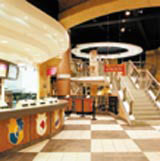Beneath the arches
Richard Clayton doesn’t often have lunch dates at McDonald’s, but makes an exception to meet up with the company’s UK design manager, Nicola Amery

It’s so easy to be critical of McDonald’s, isn’t it? The very word is a signifier for globalisation and all its attendant ills, or so the brand’s detractors would have us believe. No wonder some people can scarcely conceal their glee at its recent financial faltering.
And yet, McDonald’s continues to serve around three million customers in the UK every day. It has more than 1200 outlets and next year celebrates its 30th anniversary in the UK. In marketing terms, its success is no small fries.
However, Nicola Amery, McDonald’s amiable and house-proud UK design manager, is aware of the need to ‘reimage [sic] our stores and keep the brand fresh for our customers’. Over the summer, a refurbishment programme has progressed, after three consultancies – SHH, Softmoss and Tadcaster-based Lydiatt Plumtree – were asked ‘to come in and see what we’ve been doing and give some new thoughts’ (News, DW 15 May 2003).
Sitting in the simple but comfortable coffee bar section of McDonald’s Dunstable, created by incumbent group Adcock Clayton, it’s tempting to present the design as a radical departure. But Amery and her PR minder suggest I haven’t visited too many of their restaurants lately – they may have a point.
‘We have always done refits, probably there’s just more press about it now because we’re opening fewer stores and a bulk of money has actually been allocated,’ Amery says.
A total of £12m, in fact, is being spent this year on revamps, with some funds redirected from new openings now postponed. The strategy is not to create offers for different demographic levels – ‘we don’t grade the stores at the moment’ – but to take account of local usage patterns.
So, there are ‘grab and go’ convenience formats (some of which feature Sky News on plasma screens for breakfast customers) and ‘family-friendly environments’, with two-tier table heights for children and play or party facilities. Drive-thrus are another priority.
‘Teenagers like the booth seating,’ she says, noticing a couple of likely lads across the way. A teenage area in McDonald’s Peterborough ‘is a bit nightclubby in feel’. Amery hopes customers see such places as ‘destination venues, rather than just passing through’. Happy Days indeed.
If I had a Big Mac for every time Amery and her PR mention ‘we’re a customer-led business’, I’d have to be winched out of my ‘chunkier, timber’ chair. But Amery is determined to move her designs on, to keep them up-to-date and relevant.
‘We want to get away from the chrome, the brashness and have a more homely feel,’ she says. While Amery sets the direction, she looks to her consultants for innovative ideas and all groups are expected to work collaboratively.
‘Everyone has an opinion about McDonald’s before they work with us. They come in thinking they can change everything overnight, but it is an evolution.’
Internally, there is ‘huge backing’ for design among executives and that has ‘always been there’. And Amery clearly appreciates the support. ‘I thought I’d stay for two years,’ she says. ‘I’ve been here 13 and I hope to stay for another ten.’
Her job involves balancing a concern for ‘ambience’ and ‘the quality of finishes’ with the realities of bulk buying and durability. Where possible, Amery likes to work with the architecture of existing buildings the company takes over, though it also has a prefabricated, ‘modular’ option.
If McDonald’s is making an effort to improve the ingredients of its food, the same goes for the materials used in design. Amery evangelises modestly about softer flooring, lower lighting and granite tabletops. With Dunstable, the patio, drive-thru lane and staff room were included in the upgrade – at a cost of £200 000 ‘all in’.
It’s starting to sound like Home Front at McDonald’s. Could it be the symbol of all-American commercialism is learning the soft sell?
‘We’ve got the golden arches subtly here,’ says Amery, showing me Luci Powers’ work on the Cutty Sark store in Greenwich. ‘In the past there used to be arches everywhere, which didn’t do much good. [She laughs and hastily corrects herself]. ‘It was appropriate at the time, but you have to move on.’
Amery exudes such a sensible, motherly air that it seems almost improper to raise the obvious questions about McDonald’s the corporate pariah. But I do, and Amanda, the watchful PR, cuts in to say that a high profile, ‘number one’ brand needs ‘broad shoulders’. Not half.
Later, Amery adds, ‘What happens when I say I work for McDonald’s is [that] it’s always 20 questions and I have to go through the whole [explanatory] thing.’ But her focus is squarely on design, not the politics of Fast Food Nation.
‘People go “they’re all the same”, and my husband warns, “she’ll get the portfolio out if you’re not careful”. Friends of mine don’t realise how broad it is. They might know their local one and when they travel they’re probably in a rush, so they’re quite surprised when I show them.’
For the brand, the proof is no doubt in the consuming. Amery reflects, ‘I’m hoping when the customer walks in they will react and realise it’s a different experience.’
Nicola Amery’s CV
1990-present McDonald’s, currently UK design manager; joined as junior designer and promoted to senior designer in 1994
1989-90 Harlow Design
1987-89 The Design Solution
1986-87 Parkinson, Reynolds and Hatton
1983-86 Saunders Design Company
Graduated BA (Hons) Interior Design, Middlesex University
-
Post a comment



